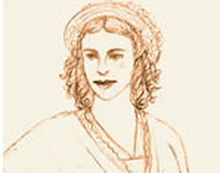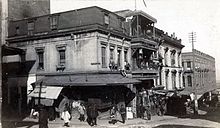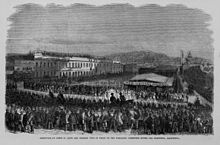Belle Cora
Belle Cora | |
|---|---|
 Representation of Cora | |
| Born | 1827 Baltimore, Maryland, U.S. |
| Died | 1862 (aged 34–35) |
| Other names | Arabella Ryan |
| Occupation | Madam |
Belle Cora (1827?
Early life
Two portrayals of Belle Cora's childhood exist.
Career

In December 1849, the couple moved to
In 1852, Belle set up a parlor house on Washington street, in
Murder of Richardson and the aftermath
Belle Cora held a competing party (which had more guests) the same night as the wife of U.S. Marshal William H. Richardson, which is said to have begun a rivalry between the women.[9] The feud was further provoked one evening at the American Theatre.[10] Richardson's wife complained to the manager that the Coras were seated in the same balcony as she was, as she felt that area should be reserved for more respectable guests.[1][11][12][13][10] However, the manager refused to remove the couple, saying that they were regular customers of the first balcony.[10] William left swearing vengeance upon Charles.[10]
On November 17, 1855, between 6 and 7 o'clock,[citation needed] Charles Cora shot Marshal Richardson in the breast in front of Fox and O'Connor's store on Clay street between Leidesdorff and Montgomery Street.[14] He died instantaneously from the wound.[15][16][14] Charles Cora was arrested, handed over to the city marshal, and later placed in the county jail.[14]
Protests and lynch mobs erupted after the murder, so Mayor James Van Ness placed Charles under a higher security accommodation for his own safety.[17] Local citizens raised fund for a monument for Richardson in the Lone Mountain Cemetery and $15,000 for his children.[14][18]
Belle funded several attorneys to represent Charles Cora including Edward Dickinson Baker and James A. McDougall.[19] Belle paid Edward Dickinson Baker $15,000 of his $30,000 retainer in gold and sent meals to Charles Cora while he was in jail.[8] In addition, she even went so far as trying to bribe the star witness Maria Knight to change her testimony.[20] Alleging that Richardson had threatened Charles with a knife, the lawyers framed the case as one of self-defense.[15] On 1856 January 17, Charles's trial ended with hung jury.[21]
On May 15, 1856, the 2nd Committee of Vigilance was formed, and by May 17, the committee had gained 2500 members. The collected guns and began to conduct "army" drills.[citation needed] The following day, 3,000 armed members of the committee took Charles and James P. Casey.[22] On 1856 May 18, in Sacramento, Governor Johnson, in response,[18] appointed William Tecumseh Sherman as the Major-General commanding of the San Francisco division of the California State Militia.[citation needed] The related case of James Casey (who had shot newspaper editor James King of William in an assassination attempt) prompted the committee to aim a cannon at the jail and demand the release of Charles and Casey.[23][24][25][19][26][27]

The 2nd Committee of Vigilance scheduled a new trial for 1856 May 20;[28][29] James King of William died the same day.[30] Samuel Brannan delivered a speech on justice and the enforcement of the law before the trial.[31] Both men were found guilty, and on 1856 May 22, the committee sentenced both to hang the following day at noon.[14][29] Before the execution, Belle and Charles got married by Father Michael Acoltti.[citation needed]
For fear of escape, 3,000 men and two field pieces led Charles to his execution,[14] at the committee's headquarters at 41 Sacramento Street in front of a crowd of 20,000.[citation needed] Charles said nothing as the noose was placed around his head.[citation needed] The cord was cut at twenty minutes past one o'clock, leaving Charles to drop six feet and hang for fifty five minutes before being turned over to the coroner.[32][33][34][29]
Death and legacy
Belle Cora died at 35, in 1862, of pneumonia. She was buried in the
Karen Joy Fowler's alludes to Cora's influence on social norms in novel Sister Noon.[9][38] During a societal shift toward "civilizing" society, Belle had maintained her business, which had been seen as immoral.[1] In the book Arresting Dress, the author Clare Sears opines that Cora inspires female financial agency and the use of sex for empowerment.[10] In addition, Cora advocated against gender stereotypes, as demonstrated by her legal battle with the Vigilance Committee;[how?] ultimately she set the precedent to resist further legislation like that of sodomy laws in the 20th century.[10]
See also
Footnotes
References
- ^ a b c d e f g h i j k l Jensen 2012, p. 360.
- ^ Levy 2013, p. 150.
- ^ Levy 2013, p. 149.
- ^ Connatix (June 12, 2006). "Gambling in the Old West". HistoryNet. Historynet LLC. Retrieved February 11, 2020.
- ^ Levy 2013, p. 154.
- ^ Lunsford, Sarah (January 21, 2010). "Take a chance on a longshot". Calaveras Enterprise. Retrieved February 12, 2020.
- ^ Taylor, William (1858). California life illustrated. New York: Carlton & Porter. Retrieved February 12, 2020.
- ^ a b Jensen 2012, p. 361.
- ^ JSTOR 4382972.
- ^ a b c d e f Sears 2015.
- ^ Kamiya, Gary (February 20, 2015). "Cheating, violence in the cards at Gold Rush's gambling dens". SFChronicle.com. Retrieved February 11, 2020.
- ^ a b Gentry, Curt (1964). "The Madams of San Francisco: An Irreverent History of the City by the Golden Gate". Doubleday – via Google Books.[ISBN missing]
- ^ Hurtado 1999, p. [page needed].
- ^ a b c d e f "Eyewitness: San Francisco Committee of Vigilance". 1856. Retrieved February 26, 2017.
- ^ a b Duke 1910, p. 21.
- ^ Wilson, John L. "Stanford University School of Medicine and the Predecessor Schools: An Historical Perspective: Part II: E.S. Cooper in San Francisco. Chapter 11. The Vigilance Committee of 1856 – Medical History Center". lane.stanford.edu. Retrieved February 11, 2020.
- ^ Woolley 1913.
- ^ a b California in Time: The Fight over Slavery through the Civil War parks.ca.gov
- ^ JSTOR 25158368.
- ^ Levy 2013, p. 171.
- ^ "Gold Rush Chronology 1855–1856". www.sfmuseum.net.
- ^ "California Historical Landmark #192: Site of Jenny Lind Theatre and San Francisco City Hall in San Francisco". noehill.com.
- ^ Duke 1910, pp. 21, 22.
- ^ Williamson 2012, p. [page needed].
- ^ Kamiya, Gary (July 26, 2014). "Demagogue editor fired up readers, revolutionaries". SFGate. Retrieved February 12, 2020.
- ^ "Hanging of Cora and Casey by the San Francisco Committee of Vigilance". www.sfmuseum.org.
- ^ Adams 2018, p. [page needed].
- ^ "Assassination of James King of William: Surrender of Jas. P. Casey and Charles Cora to the vigilance committee, on Sunday, May 18th, 1856" (Print). Library of Congress. San Francisco: Reynard Press, Inc. 1961. Retrieved February 11, 2020.
- ^ LCCN 92508320. Retrieved December 6, 2021.
- ^ Duke 1910, p. 22.
- ^ Woolley 1913, p. 11.
- ^ "Execution of Casey and Cora – San Francisco, 1856". Archived from the original on May 10, 2012. Retrieved February 26, 2017.
- ^ "Sex, Vigilantism, and San Francisco in 1856". Common-Place. 03 (4). July 1, 2003.
- ^ "The Sonoma County Journal from Petaluma, California". Petaluma, California. November 24, 1855. p. 2.
- ^ Duke 1910, p. 23.
- ^ Beyl, Ernest (September 2012). "A short history of bordellos in San Francisco, part 2". Marina Times. Retrieved February 11, 2020.
- ^ Jensen 2012, pp. 361–362.
- ^ Fowler 2002, p. [page needed].
Works cited
- Adams, Charles F. (2018). Murder by the Bay: Historic Homicide in and about the City of San Francisco. Quill Driver Books. ISBN 978-1884995460– via Google Books.
- Duke, Thomas Samuel (1910). "Famous Vigilance Committee and Battles With Squatters". Celebrated Criminal Cases of America. San Francisco: James H. Barry Company. pp. 20–22. OCLC 3811019. Retrieved February 12, 2020.
By Thomas Samuel Duke, Captain of Police, San Francisco; Published with Approval of the Honorable Board of Police Commissioners of San Francisco, 1910. (Public Domain Free Download)
- Fowler, Karen Joy (2002). Sister Noon. Penguin. ISBN 978-1-101-65984-7. Retrieved February 11, 2020.
- Hurtado, Albert L. (1999). Intimate Frontiers: Sex, Gender, and Culture in Old California. UNM Press. ISBN 978-0826319548– via Google Books.
- Jensen, Vickie (2012). Women Criminals: An Encyclopedia of People and Issues. ABC-CLIO. ISBN 978-0-313-33713-0. Retrieved February 11, 2020.
- Levy, JoAnn (2013). They Saw the Elephant: Women in the California Gold Rush. University of Oklahoma Press. ISBN 978-0806189932– via Google Books.
- Sears, Clare (2015). Arresting Dress: Cross-Dressing, Law, and Fascination in Nineteenth-Century San Francisco. Duke University Press. ISBN 978-0-8223-7619-4. Retrieved February 12, 2020.
- Williamson, G. R. (2012). Frontier Gambling. G.R. Williamson. ISBN 978-0985278014– via Google Books.
- Woolley, Lell Hawley (1913). California, 1849–1913; or, The rambling sketches and experiences of sixty-four years' residence in that state. Oakland, CA: De Witt & Snelling.
General references
- Weirde (1994). Dr. Weirde's Weirde Tours: A Guide to Mysterious San Francisco. San Francisco: Barrett-James Books. ISBN 978-0-9643559-0-3.
